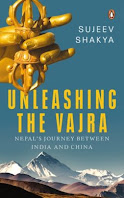Book Review: Unleashing the Vajra: Nepal’s Journey between India and China
Unleashing the Vajra: Nepal’s Journey between India and China
Sujeev Shakya (2019), “Unleashing the Vajra: Nepal’s Journey between India and China”, Penguin Random House India Pvt. Ltd.
Unleashing the Vajra: Nepal’s Journey between India and China touches extensively on the past that shaped Nepal’s present
and its prospective future in-between two of the world’s largest economies
India and China. Furthermore, it also recommends strategies for transforming
Nepal’s possibilities into reality.
Sujeev Shakya, the author of this book is a well-known name in
Nepal who writes and talks extensively about Nepal’s economy. Shakya is also
the founder of Beed Management and Nepal Economic Forum. The book is divided
into three parts: The Past, The Context, and Action Time pertaining to Nepal’s
socio-economic development. The Vajra as per Shakya symbolizes “an irresistible
force carried by millions of Nepalis worldwide that will bring about positive
transformation”.
The beginning of the book starts with Shakya sharing his views
and thoughts on Nepal’s past starting with Nepal Sambat stating briefly about
the Lichhavis, Mallas, Ranas, and finally the Shahs. He highlights the cultural
aspects that linked Nepal to its neighbors viz; Araniko, Buddhism, the Newar
traders, etc. There is the mention of the caste system that according to the
writer is the reason for the rent-seeking mentality of Nepalese. Then there is
the fall of Shahs to Rana autocracy after the death of King Prithivi Narayan
Shah, founder of unified Nepal.
After talking about the past, the author moves towards the
present context of Nepal. Starting with cartels that are prevalent in the
private sector which have in many ways hindered the development of a free-market
economy in Nepal. But there is the optimistic view argued by Shakya where he
mentions the success stories of the private sector such as Bhatbhateni
Supermarket, and Kantipur Publications.
Entrepreneurship is a term widely discussed in the past couple
of decades throughout the world including Nepal. In discussing the rising
enterprising mindset of the young Nepalese the author points out ventures such
as Goldstar, Himalayan Java Coffee that have successfully expanded both
domestically and internationally. Service sector is now contributing
a larger share in Nepal’s GDP. It is a result of as Shakya states the smiling
nature of Nepalese.
Furthermore, the writer discusses the tendency of overreliance
on foreign aid for development that started with the US-led Marshall plan in
1951. This issue of donor and development is still pertinent in Nepal in many
ways such as the recent controversy surrounding the Millennium Challenge
Corporation (MCC) package by the US.
The trend of migration, diaspora, and remittance is an old
phenomenon that has also been highlighted in the book along with the historical
background of Newari traders, Gorkha recruitment. And in contemporary Nepali
society the trend of going abroad for higher education and labor. The scrivener
explores the challenges and opportunities with regards to the Non-Resident
Nepalese (NRN). The global Nepalese as per the book will bring about the
maximum transformation in Nepal as they bring in new ideas and implement them
locally.
Shakya proposes Vision 2030
as Nepal graduates to a middle-income country. There are suggestions for
reforms on tax, land, capital market, labor, and the financial sector that
highlight the key issues in these sectors. Then there is the acronym that
Shakya uses of HATS (Hydropower, Agriculture, Tourism and Services) along with
I (Infrastructure). These represent sectors that will prove to be crucial for
Nepal’s development.
Through the means of sub-headings, the author is successful in
eloquently presenting Nepal. This piece is a unique one considering the broad
range of sectors. It covers not just the economic lens but also the political,
socio-cultural, and historical perspectives. Therefore, in my opinion, it is a
must-read book for students, young professionals, policymakers, and anyone who
believes in “The Vajra”- the power of Nepal to unleash its potentials, as the
writer puts it.




Comments
Post a Comment